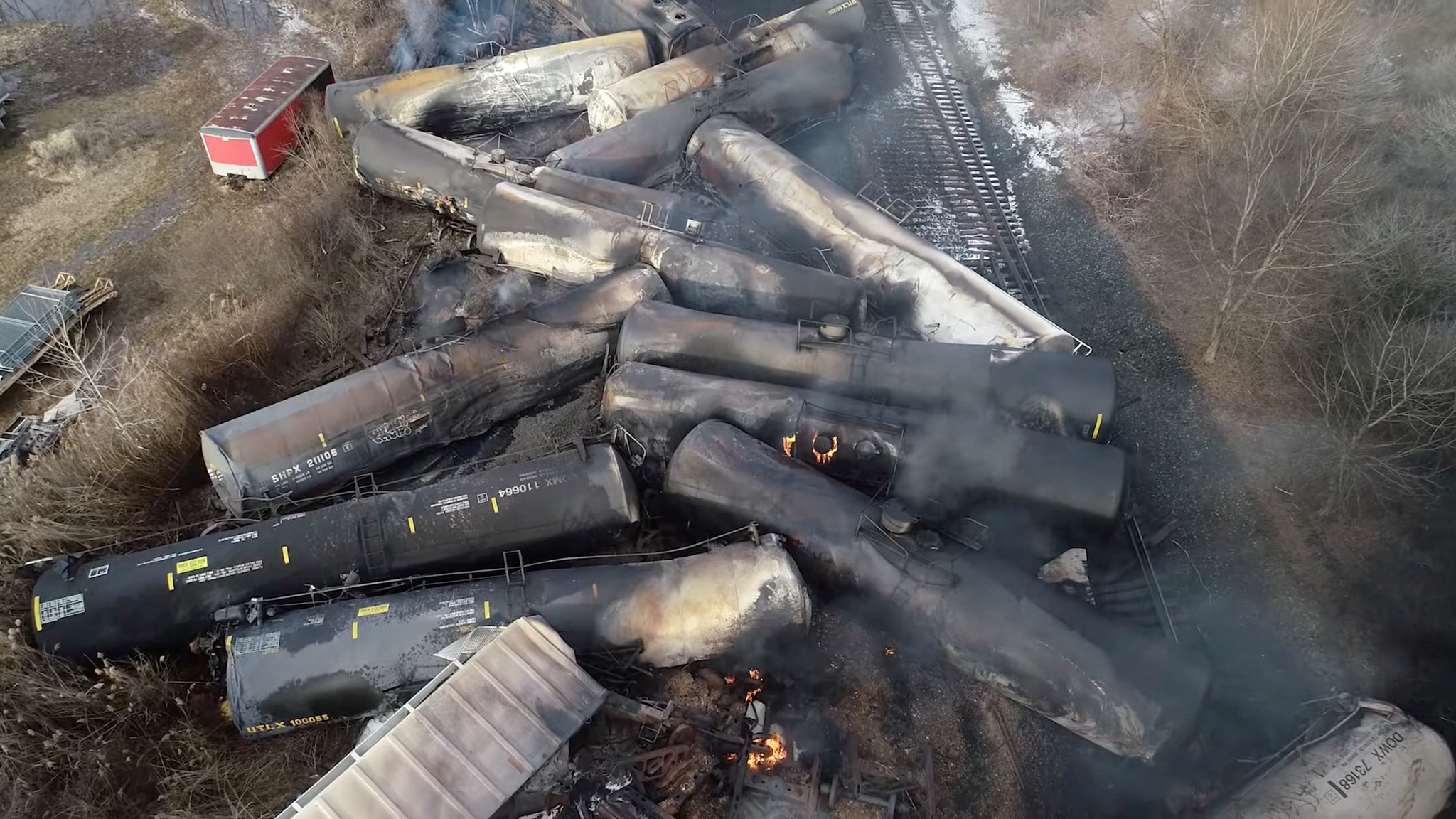
Less than a week after a train carrying hazardous materials derailed in northeast Ohio, burst into flames and stoked fears of a “potential explosion,” authorities assured residents who were forced to flee their homes that they had already it was safe to return to the city. But Maura Todd isn’t convinced.
The headaches and nausea her family experienced in their home last weekend and the strong odor that reminds her of a mix of nail polish remover and burnt tires told her otherwise. On Saturday, she planned to pack her bags and move from East Palestine, Ohio, to Kentucky with her family and three Miniature Schnauzers – at least temporarily.
“I’ve watched all the interviews and I haven’t heard anything that makes me think this is a data-driven decision,” Maura Todd, 44, tells The Washington Post. “We don’t feel enough information has been shared.”
After the derailment, federal and local officials repeatedly assured residents that the air quality was safe and the water supply was not contaminated. But more than a week after the South Norfolk train derailed – causing an explosion that sent flames into the air and a cloud of smoke that covered parts of this locality and which, to avoid an explosion, also forced authorities to release a dose of chemicals being transported – locals told The Post that they had yet to see a complete list of what was on board when it lost course.
So, without much information, residents and experts told The Post that they question whether it’s safe to return to their homes a week after pollutants have run into local streams and been released into the air. In some locations, dead fish had been sighted, a state official confirmed, and residents returning to their homes in a nearby Pennsylvania town were advised by officials to open their windows, turn on fans and clean all surfaces with diluted bleach.
“The biggest question right now is what, if anything, is still being released from the site above all else,” says Peter DeCarlo, a professor of environmental health at Johns Hopkins University. “If there are still residual chemical emissions, then this still poses a danger to people living in this area.”

The accident
It was 9pm on February 3rd when 50 carriages on a South Norfolk train, which had 141 in all, derailed, causing a fire near the dangerous reagents, which kept firefighters away for days. The derailment, which caused no casualties, was likely caused by mechanical problems in one of the railcars’ axles, the National Transportation Safety Board (NTSB) said.
The incident caused further concern nearly 48 hours after it took place, when changing conditions in a rail car caused authorities to warn of a possible “big explosion”. Authorities conducted a “controlled release” of vinyl chloride on Monday to prevent an explosion, and on Wednesday allowed residents to return.
According to Eric Whitining, who lives in this area, there are nights when the air smells like “pool with excess chlorine” and your eyes sting. This resident returned to his home on the day the authorities lifted the evacuation order. Eric stresses that he cannot move his family of five away from home, so he says he has no choice but to stay and follow the instructions of the authorities.
“For a small town, we have to trust them, because what else can we do?” he asks. “We have to trust that they are not lying to us.”
More than 1,000 people — residents, local businesspeople, and anyone else who might have been harmed by the exposure — were affected, according to data contained in one of four lawsuits Ohio and Pennsylvania residents filed against Norfolk Southern.
That lawsuit, filed Wednesday by East Palestine residents Ray and Judith Hall, alleges Norfolk Southern’s negligence led to the derailment. The suit, which seeks financial redress, medical care and more, alleges residents were exposed to toxic substances and incurred costs due to the evacuation and suffered “severe emotional distress” and anxiety.
Norfolk Southern spokesman Michael L. Pucci said the railroad could not comment on the litigation. For now, the company has set up a “family assistance center” and is reimbursing residents who have fled their homes, though Pucci declined to say how many people it has included or how long help will continue.

Residents want details on toxic load
The Environmental Protection Agency (EPA) stated that the main chemicals involved were vinyl chloride, its by-products phosgene and hydrogen chloride (hydrochloric acid), butyl acrylate, and others. But neither the EPA nor the NTSB published a complete list of what the train carried.
Asked whether Norfolk Southern would release the list, Pucci referred The Post’s question to the NTSB, which is investigating the derailment. An NTSB spokesman said the list would form part of the agency’s document on the tragedy, which is usually published after months. EPA spokeswoman Rachel Bassler said the agency had listed the chemicals that “posed the most acute impacts to the community.”
Some experts said the EPA’s monitoring of the air should have been done with more sophisticated devices and that it was unclear whether the agency had enough data when it told residents the air was safe. “In any of these situations, the EPA will monitor with the tools they have at their disposal, but that doesn’t necessarily mean that’s the best way to monitor,” said DeCarlo of Johns Hopkins. “The portable monitors that were being used are adequate, but often don’t have the necessary sensitivity or chemical specificity to really assess whether there is a risk.”
“The amount of chemicals that have been spilled and burned doesn’t just disappear,” said resident Nate Velez.
Judith Enck, a former EPA regional administrator, agreed. She considers that the EPA was “unconscious” when it did not publicly release the list of all the chemicals that were in the convoys. The agency, she said, should launch a website that displays test results “in a way that is easy for the public to understand.”
“At the very least, people should know what was in each car on the train,” added Judith Enck. “This is a time when maximum transparency is needed.”

Play it safe or take the risk
The EPA provided its air monitoring data to health agencies before allowing residents to return, said Rachel Bassler, an agency spokeswoman. Since the fire was extinguished, air control has not detected levels of hazardous chemicals, she added.
About 450 people signed up to have the air in their homes screened, an option offered by Norfolk Southern and backed by the EPA. As of Friday night, 105 homes had been screened and no vinyl chloride or hydrogen chloride was detected in any of them, said Rachel Bassler.
Although vinyl chloride is carcinogenic, its worst effects have generally been documented after prolonged or high-volume exposure, according to federal reports. “Short-term exposure to low levels of substances associated with the derailment does not pose a long-term health risk to residents,” Norfolk Southern assured in a document that was distributed to residents with answers to frequently asked questions.
However, the question is whether enough contaminants have been released to cause long-term effects. Nate Velez, 31, whose home and business are situated near the train tracks, said his family doesn’t plan on returning home, which still smells of chemicals, and Velez said his wife, a nurse, “doesn’t want to run any risks” with the amount of toxic chemicals that were dispersed.
“We are relying on our five senses because [as autoridades] don’t tell us much,” said resident Maura Todd.
“The amount of . . . chemicals that have been spilled and burned don’t just disappear,” he says. “I don’t think there’s any way to know the full effect until enough time has passed. And it’s just not worth the risk.”
Maura Todd and her family drove from East Palestine to Lexington on February 5 to stay with her family until authorities deemed the city safe enough for residents to return. But when that happened, Maura considered that she would first visit the site and check the current situation before a possible return to the city.
So on Sunday, Maura Todd and her husband, who had spent the night at a hotel in Salem, Ohio, after returning from Kentucky, drove to their East Palestine home, masks over their faces, for an evaluation. Her son and three dogs stayed in Lexington. And they vent: “We are relying on our five senses because [as autoridades] they don’t tell us much.”
Originally published in the Portuguese newspaper “O Público”
Join our WhatsApp group, click on this link
Join our Telegram channel, click on this link
Source: https://www.diariodocentrodomundo.com.br/ohio-o-medo-de-voltar-para-casa-apos-um-desastre-apelidado-chernobyl-2-0/

